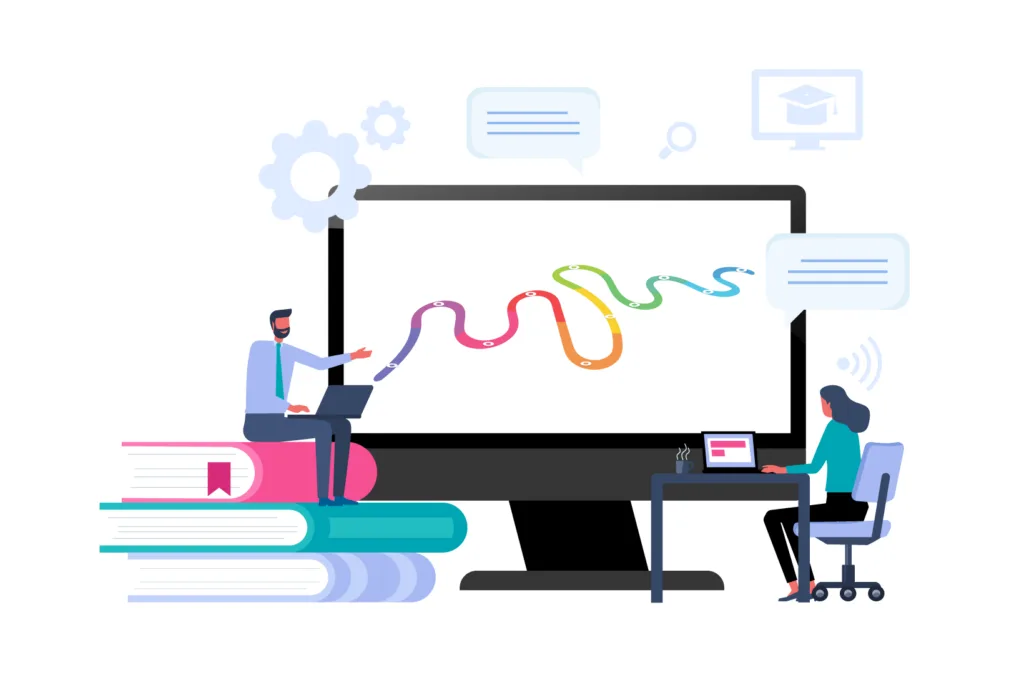Did you know that the human attention span is only 8 seconds? This means that online course creators now need to find creative ways to hold their students’ interest and keep them engaged and motivated in their online courses.
That’s why gamification has become one of the key components in creating a successful online course. Aside from having to plan and create the content, online course creators must now come up with ways to gamify their courses if they want to succeed in the long run.
✅ By incorporating game elements into online courses such as points, badges, and progress tracking, course creators can make learning more interactive and enjoyable for their students, therefore increasing the success of their courses.
But what is gamification, and how do you actually gamify your online course? We’ll answer these questions in this article.
What Is Gamification in Learning?
One of the biggest challenges you face as an online course creator is how to keep your students engaged and how to make sure they’re actually remembering what they’re learning from your course.
When students are being forced to learn without the aid of interaction, they often feel disconnected and unmotivated. But when they’re having fun, they’re much more likely to remember and retain information for longer.
That’s why gamification is such an effective method to engage and motivate students to smash through their learning outcomes.
In fact, statistics show that 67% of students prefer gamified learning over traditional courses, and those exposed to challenge-based gamification improved their performance by up to 89.45% compared to those who only attended lectures.


Gamification is introducing game-like elements into the learning process. For online learning, this can be anything from assigning points for completing lessons or levels, incorporating progress bars to track advancement, or implementing quizzes and challenges.
Another form of implementing games into learning is game-based learning.
Unlike gamification, where game elements are integrated into the course structure, game-based learning involves students actively participating in actual games that serve as the primary mode of instruction.
Here’s a short video that explains how gamification works and how you can implement it into your courses with AccessAlly:
7 Main Benefits of Gamified Learning
Gamifying your online courses has a multitude of advantages that can help you significantly improve the learning experience for your students and have a positive impact on your business.
Here are the 7 main benefits of gamification you need to be aware of.


1. Gamification Increases Student Engagement
According to an article in the Journal of Education for Business, 67.7% of students found gamified learning more motivating and engaging than traditional courses.
Take Duolingo, for instance. If you’ve ever used it to learn a new language, you know that the platform makes learning an almost addictive experience that motivates you to keep learning.
🤩 That’s the power behind gamification. By introducing game-like elements into the learning process, gamification increases learner engagement and stimulates friendly competition that keeps them motivated to keep learning and complete the course.
Plus, the element of fun and interactivity reduces boredom and fatigue, making learning feel less like a chore and more like an exciting new experience, which, in turn, increases engagement.
2. Gamification Increases Student Retention
Incorporating game-like elements in their courses can help course creators increase student retention.
📈 Interactive elements like quizzes, leaderboards, and points make the learning process more enjoyable and rewarding for students, so they’re more likely to stick with the course and see it through to completion.
It’s like leveling up in a game — you earn points, unlock achievements, and climb the leaderboard as you go. This not only keeps students excited about their learning journey but also encourages them to stay committed and see it through to the end.
3. Gamification Makes Learning Fun and Interactive
We’re naturally wired to seek experiences that bring us pleasure and satisfaction.
When we engage in activities that trigger these feelings, such as completing a challenging level or earning a badge in a game, our brains release dopamine, a neurotransmitter associated with pleasure and reward.
This dopamine rush makes us want to repeat the action that triggered it.
⭐ In the context of gamified learning, this means that when students achieve milestones or progress through levels, they experience a sense of accomplishment and satisfaction, which keeps them actively engaged and motivates them to continue learning.
Therefore, your students are more likely to engage with your course material if it’s fun and interactive. By using gamification to make your courses more fun and interactive, you can increase learner engagement and motivate your students to complete your course.
4. Gamification Provides Real-Time Feedback
In gamified learning, you can offer real-time feedback to students as they progress through your online course. By incorporating elements that reward and acknowledge students for their achievements, you keep them engaged and motivated to continue learning.
Whether it’s issuing badges or awarding points based on progress, gamification allows for immediate feedback that helps students keep track of and celebrate their achievements.
Conversely, if a student fails to pass a quiz necessary to unlock the next level or module, you can prompt them to retake the quiz or review the material.
🥇 This instant feedback loop helps students identify areas for improvement and encourages active participation by tapping into the reward centers in their brains.
5. Gamification Improves the Learning Experience
A great learning experience can make or break your course. If your students don’t enjoy the learning process, they’re more likely to drop out or simply forget about it halfway through.
If your students fail to complete your courses, it can negatively impact your business in several ways.
Firstly, increased dropout rates can lead to higher churn and refund rates. Secondly, if your students aren’t achieving the desired results, they’ll be less inclined to buy more courses from you in the future.
Gamification can help you immerse your students in the learning process with fun elements, like challenges, quizzes, or point rewards.
🥳 By improving their learning experience, you not only make sure that they’re actually learning but that they’re also enjoying the process, which will help you turn them into recurring customers who sing your praises to others.
6. Gamification Creates a Personalized Learning Experience
Gamification makes learning feel more personal by allowing students to go through the course at their own speed while getting feedback and receiving rewards that match their progress and learning style.
By incorporating elements such as branching paths, adaptive quizzes, and personalized challenges, gamified courses adapt to each student’s learning style, pace, and preferences, making the learning process feel like it’s been designed for them.
🎒 Having a learning experience that feels like it’s been crafted just for you makes it easier to stay engaged and enjoy the learning process.
7. Gamification Improves Knowledge Retention
When you were in school or had to study something, you may have noticed that it was easier to learn new information if you were interested in the topic or were having fun.
In her book, Research-Based Strategies to Ignite Student Learning, neurologist Judy Willis proved that having fun while learning can help us remember information better.
🥰 When we’re having fun, our brains produce more dopamine and endorphins — two hormones that improve our mood. And the better our mood when we learn something, the more engaged we are in the learning process.
This heightened engagement leads to better memory retention and long-term learning outcomes.
The Challenges of Gamified Learning
Although gamification is a great way to make learning fun and engaging, it does have its challenges and limitations.
- It requires careful design
Designing gamified elements takes careful planning and attention to detail. If they’re not done right, they won’t help students with their learning process and could even hinder their learning experience.
- There’s a risk of going overboard
If your online course uses too much gamification, students might get more caught up in the fun than in actually learning. Too many game-like elements may easily distract them from their real learning objectives.
- It can be bad for intrinsic motivation
Gamification can diminish students’ intrinsic motivation by flooding them with extrinsic rewards. That’s why it’s essential to strike a balance. Too many rewards may reduce their value, while too few may not provide enough motivation.
- It requires regular updates
A gamified online course requires regular maintenance to stay relevant and engaging. Just like anything in the digital world, gamification trends change over time, so it’s important to keep up with the latest trends to keep students engaged in the learning process.
8 Gamified Learning Strategies to Transform Your Online Courses
Using gamification is a great way to create an interactive and engaging learning experience for your students. But how do you actually implement gamified learning into your courses? There are a few different ways that you can go about it.
Let’s discuss a few of the most interesting ones.
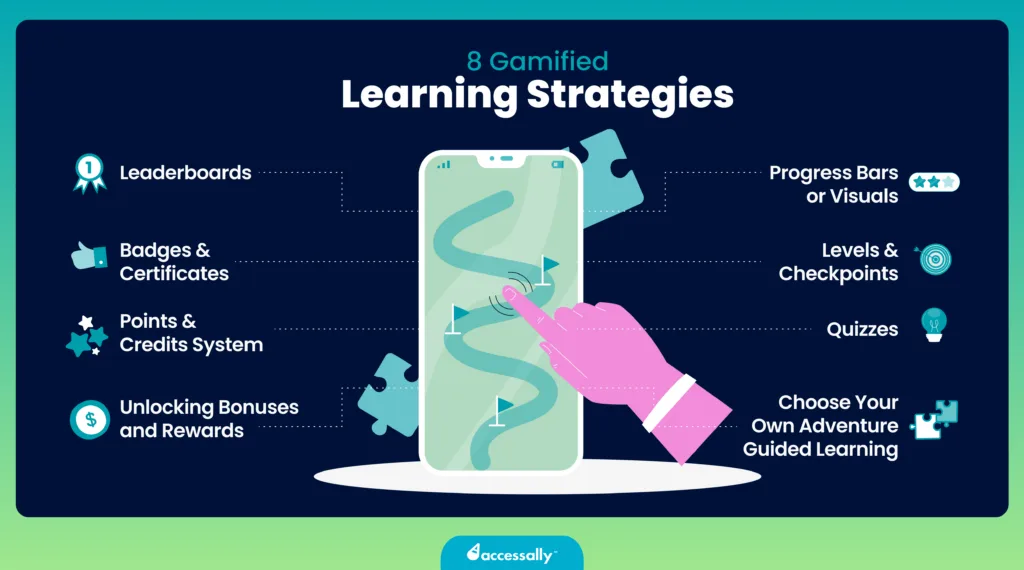

1. Leaderboards
Leaderboards are a fantastic way to add an element of friendly competition to the learning process and boost your students’ motivation to complete the course.
Essentially, a leaderboard is a ranked list that showcases users’ achievements, progress, or points earned within a particular level or activity.


There are various ways to set up leaderboards. For example, you can display badges that users earn, encouraging them to earn more badges than others on the list. Or, you can establish a leaderboard based on a points system, where users try to get more points to move up the rankings.
When incorporating a leaderboard strategy into your membership site or online course, think about how the leaderboard will benefit your students.
Aside from being a great source of motivation through competition, leaderboards provide a fun way for members to interact with each other.
In online courses or memberships where students don’t know anyone, a leaderboard linked to a member directory can help them get to know each other better. When you click on someone’s profile, you can read their bio and connect with them, which creates a sense of community.
2. Badges & Certificates
Badges are another great way to add gamification to your online courses or memberships.
Think of badges as digital awards that people can earn as they progress through your course. They’re like the gold stars you used to get in school for doing well on a test, except they’re digitalized.
Your students can earn badges for completing a module, doing well on a quiz, or getting a certain number of points. This taps into the reward center in our brains, which releases dopamine whenever we accomplish something and are rewarded or celebrated for it.
You can also display your students’ badges on the leaderboard as a form of recognition. Allowing students to download their badges and use them on their websites is a great way for them to build credibility.
Finally, consider awarding your students a completion or achievement certificate at the end of the course. This will not only motivate them to complete the course but also serve as a tangible reminder of what they’ve accomplished.
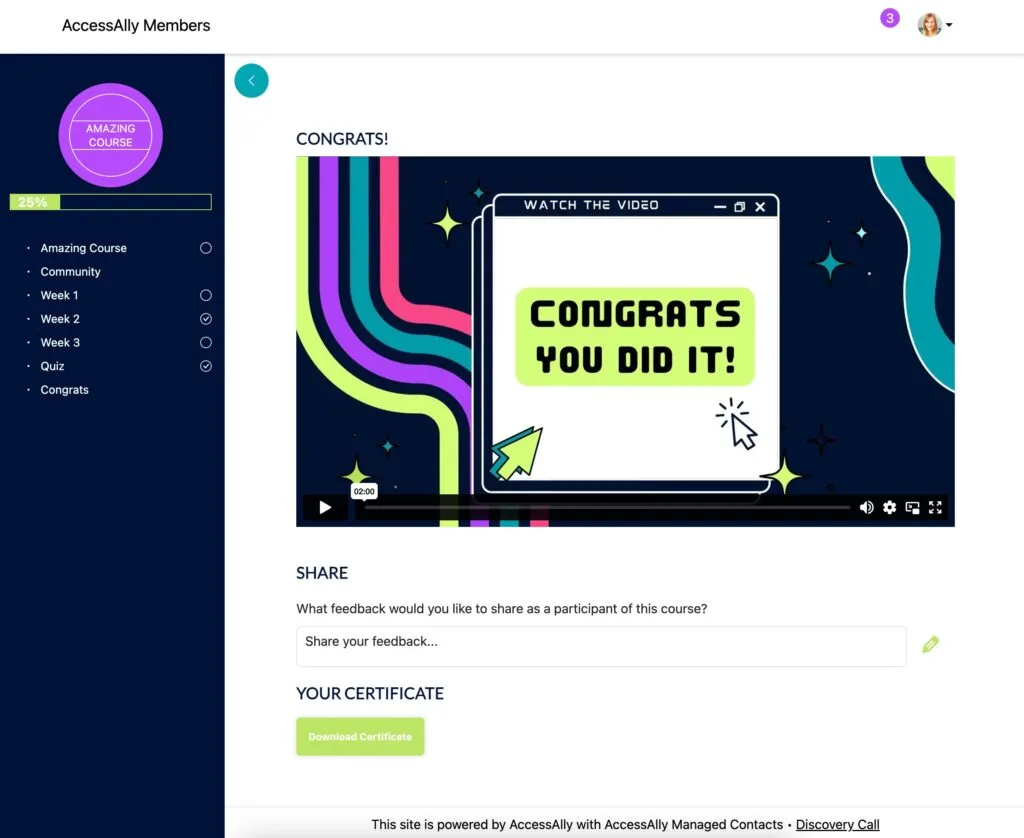

Plus, they’ll be able to share their certificates with potential employers or colleagues to show proof of their skills.
3. Points & Credit Systems
Points or credit systems are a great way to incentivize and reward students for their engagement and progress. Participants can earn points by logging in, completing learning objectives, finishing courses, or passing quizzes.


The points can then be redeemed for rewards, which can incentivize students to complete the course with the most points. The rewards can be anything, from bonus content or physical products to one-on-one coaching sessions.
It’s up to you to decide how to structure your points and rewards system. A gamified points system is like a currency, but you’re the one in charge of the value and trade regulations for your points system. And your currency can be anything you want: stars, coins, hearts, diamonds, etc.
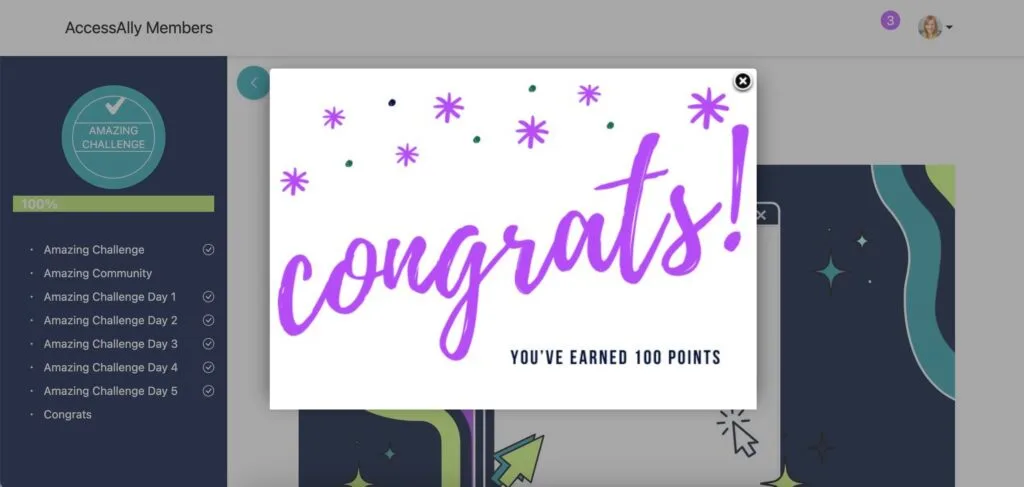

A points system makes the course more valuable and fun for students because now they’re not only motivated to learn new things, but they’re also motivated to gain the most points and redeem them for exciting rewards — whether it’s unlocking additional content or earning a 1:1 coaching session with the course creator.


Plus, when you have to spend your hard-earned points to access course material, it becomes difficult to take it for granted. This makes learning much more rewarding and encourages students to stay engaged and committed to their learning goals.
4. Unlocking Bonuses and Rewards
Like in video games, where you discover secret passages or earn rewards for achievements, you can create a similar experience for your students within a membership site or online course.
Many LMS plugins enable you to gamify your courses by allowing your students to unlock special bonuses or rewards by completing actions or redeeming points. These bonuses could include exclusive downloads, videos, or anything else you can think of to make your members feel valued and special.
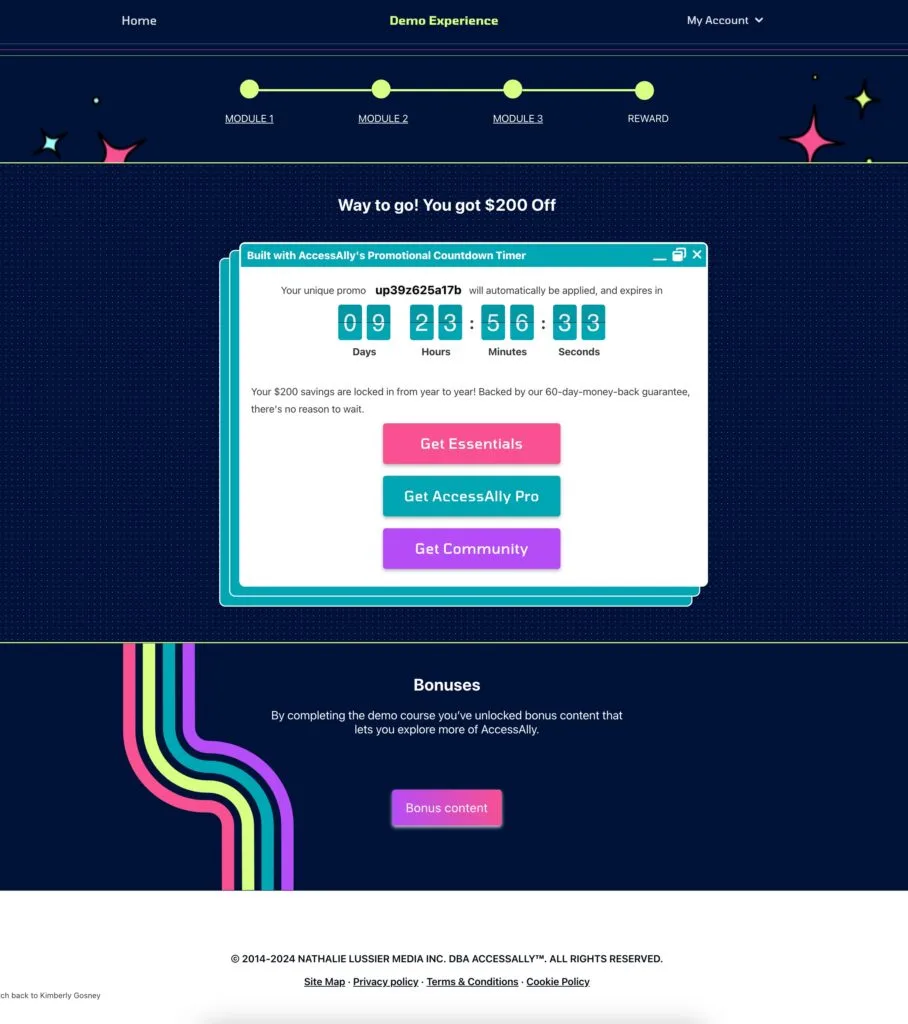

When taking a course or training, everyone wants to feel like they’re progressing and achieving something. Allowing students to unlock special bonuses after completing an action or passing to the next module of the course can help foster that sense of accomplishment and keep them engaged and motivated.
5. Progress Bars or Visuals
If you’ve ever taken an online course or quiz, you’ve surely seen a progress bar before. In an online course, the progress bar starts at 0% and fills up as the student completes each section. As they progress, the bar inches closer to 100%, showing them how far they’ve come.


Aside from giving students a clear indication of where they are in the course, this visual representation also provides a sense of accomplishment with each milestone reached. It’s like ticking off items on a to-do list — seeing their progress fuels the desire to continue.
When students see their completion percentage increasing each time they finish a lesson, pass a quiz, or complete a module, their intrinsic motivation kicks in to help keep them engaged and working towards a bigger goal.


Put simply, most people find motivation in achieving goals, whether big or small. LMS gamification leverages this by providing visible benchmarks for progress. Progress tracking helps motivate students to stay committed to their learning goals from the moment they log into their online accounts.
6. Levels & Checkpoints
Game levels and checkpoints are a great way to motivate students to continue learning. They remove the overwhelm by breaking down the learning process into smaller, manageable parts and giving students smaller goals to work towards.


Like in a video game, where you must pass through a checkpoint to save the game or get to the next level, checkpoints in an online course create a sense of accomplishment and progression, which motivates students to keep going.
Plus, levels and checkpoints allow for personalized learning. Students can move through the material at their own pace, relieving the pressure of having to keep up with a specific timeline.
7. Quizzes
It’s hard to find someone who doesn’t love quizzes. In online courses, quizzes serve several purposes that make learning more effective and engaging.
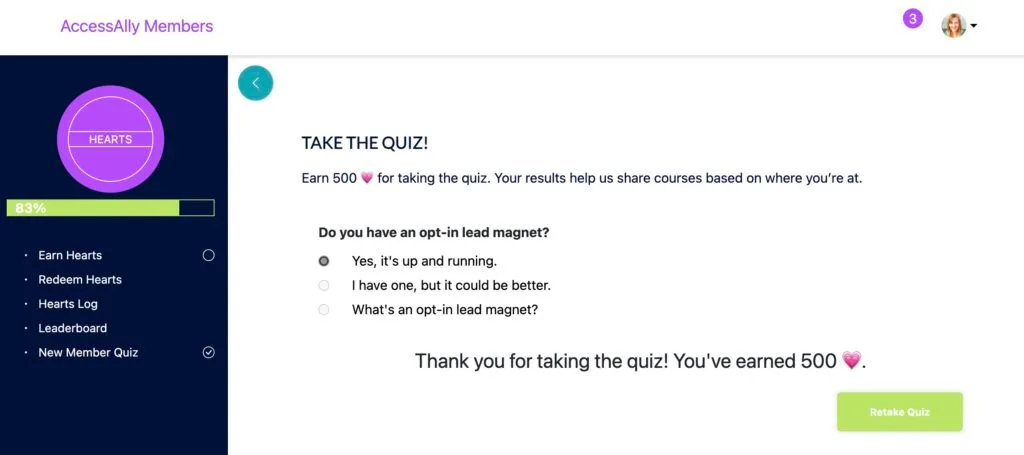

Firstly, quizzes offer instant feedback, helping students see what they know and what they need to work on right away. Secondly, they make learning active. Instead of just reading or listening, students have to recall information, which boosts their understanding and memory.
Plus, quizzes can be turned into games by adding time limits, scores, and leaderboards. This competitive element motivates students to do better and keeps them hooked.
8. Choose Your Own Adventure Guided Learning
Have you ever played a “choose your own adventure” game? It’s like being the director of your own story, where your decisions shape the outcome.
Now, imagine bringing this interactive storytelling element into your online course. You can create a gamified learning environment where students get to choose their own path through the content. Like in a video game, different pathways can be unlocked based on the student’s previous choices and mastery of the material.
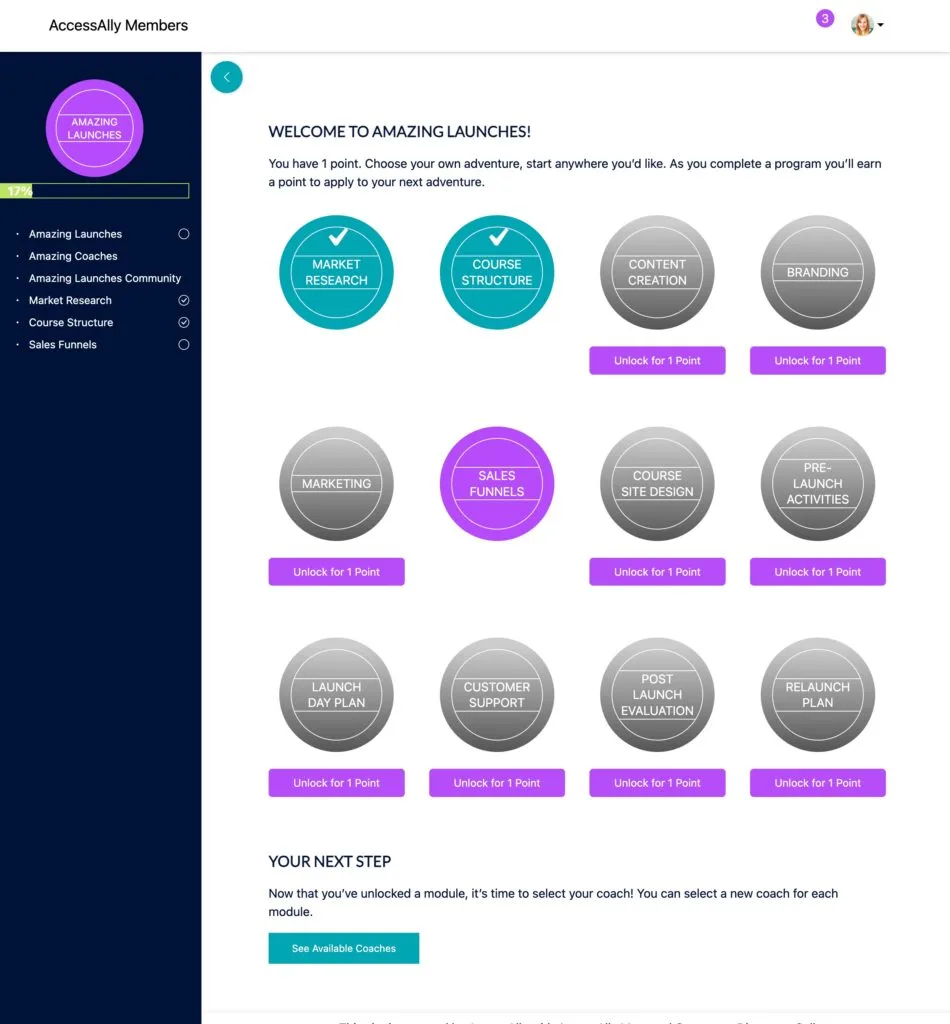

This is an excellent idea if you offer multiple courses within your membership site, as it helps guide students through the material that’s most relevant to them. By focusing on their chosen path, students won’t get distracted by other courses.
You don’t have to limit yourself to the standard “choose your own path” method. You could get creative and design a virtual escape room, a murder mystery experience, or even an online scavenger hunt.
If you’re looking for inspiration on how to gamify your online course, watch this video where we go over 10 gamification examples done right.
Best Practices for Implementing Gamification
Mixing games with learning can help you create fun-filled yet result-oriented online courses your students will find both entertaining and educational. But before you start gamifying all of your online courses, there are some things you need to keep in mind.
Here are some best practices for implementing gamification into your online courses and memberships.
Choose the Right Tools
As an online course creator, you’re likely using an LMS plugin to build your online course. If you’re still on the hunt for the perfect tool, check out our comparison guide of the best online course platforms to find the best fit for your needs.
To gamify your online course, you need a tool that seamlessly integrates with your existing setup to create the best possible user experience.
With AccessAlly, you get an all-in-one solution that allows you to incorporate game-like elements into your courses without add-ons or third-party tools.
If you’re looking for an add-on or third-party tool to enhance your existing setup, GamiPress, myCRED, and BadgeOS are some popular gamification plugins.
However, these add-ons often fall short in terms of integration and functionality and don’t deliver the same flexibility you’ll find with an LMS with built-in gamification features.
Align Gamification With Learning Objectives
A gamified e-learning program is not just about integrating entertaining elements. The key objective is infusing these game elements to deepen comprehension and promote retention of learning materials.
For example, consider a topic like environmental conservation.
Learners can earn reward points or badges by engaging in a simulated cleanup activity, saving digital fauna, or making conservation decisions, thus matching the environmental conservation agenda.
Design Engaging Game Mechanics
The key to a great learning experience lies in mastering game mechanics. You can do this by integrating design elements such as quests and missions or unlocking new modules after completing previous ones successfully.
Think of it like metaphorical ledge climbing — progressing through topics of increasing difficulty or complexity, just like in a video game where you must overcome challenges to get to the next level.
Create Meaningful Challenges
Gamification embraces the heart of all games: challenges.
Drafting simple to complex challenges promotes active learning and problem-solving, simulating a genuine game experience in a learning environment.
For instance, beginning with a fill-in-the-blanks test and escalating to a full-fledged quiz can provide a competitive edge, motivating students to push their boundaries.
Leverage Rewards and Badges
Badges and rewards are the backbone of gamification. But remember, balance is critical. If it’s too easy, there’s no satisfactory challenge. If it’s too hard, it could dampen your students’ spirits.
Let’s say you have set up a badge system for a programming course, where students get badges for successfully coding. If you don’t set the bar right and hand out badges too easily, or on the other hand, not easily enough, it might confuse the learners about their progress level and lead to demotivation.
That’s why designing a balanced rewarding mechanism that aligns with the learning outcomes and keeps up the motivation levels is essential.
4 Inspiring Examples of Gamification in E-Learning
Many online course creators are now implementing gamification into their online courses to make learning more engaging and enjoyable. If you’re looking to gamify your courses, AccessAlly offers powerful gamification features your students will appreciate.
Let’s take a look at some real-life examples of how our clients have used AccessAlly to gamify their online courses.
Sales Insights Lab


Sales Insights Lab provides valuable resources, including coaching, mentorship, and training, to address the challenging task of winning business deals.
Their goal is to empower both businesses and salespeople. Enabled with self-management options for teams, the platform facilitates individualized learning journeys.
In their journey to build an effective online training offering, they chose AccessAlly due to its smooth integration with their existing systems.
Leveraging the power of AccessAlly, Sales Insights Lab incorporated interactive elements such as progress tracking and quizzes into their e-learning platform, ensuring an engaging and effective learning experience for users.
The strategic decision to gamify the platform met with striking results:
- Membership increased threefold, with one-click upsells accounting for 25% of revenue.
- Selling memberships to corporations led to a 20% increase in revenue in the past year.
Endorsing the effectiveness of the platform, Marc Wayshak of Sales Insights Lab remarks,
“AccessAlly has been huge for us. Super easy to use, very professional looking… The quizzing functionality allows me to sell my membership program to corporations, which also added another 20% in revenue in the past year.”
Ma Yoga®


Ma Yoga®, an online yoga membership platform built by Jessica Jennings, serves as a haven for mothers and expectant mothers.
Here’s how Ma Yoga® has adeptly harnessed AccessAlly’s power, leveraging gamification and technology, to offer users a more personalized, rewarding, and engaging experience.
- Innovative gamification: To increase user engagement, the platform has rolled out a gamification strategy known as “Karma Points.” Here, members earn points for participating in certain activities, which they can redeem for discounts on premium offerings. This clever strategy fosters continual member activity and improves the feeling of reward and achievement.
- Personalized experience: The platform uses AccessAlly and ActiveCampaign to create curated programs. With users receiving a unique tag corresponding to their stage in motherhood upon sign-up, they are sent a tailored care package, thereby creating a deeper connection with the content.
- Emphasis on community building: By employing BBPress along with AccessAlly, Ma Yoga® set up an integrated forum that allows both current paying users and free members to exchange experiences, advice, and support. The platform thus fosters a powerful community atmosphere, furthering user engagement and driving enriched learning experiences.
Shannon Mattern


Shannon Mattern is making waves in the web design industry, providing quality training for female web designers.
She focuses on empowering professional women to land profitable projects, effectively manage their workloads, and maximize their earnings.
Shannon initially opted for OptimizePress, a cheaper platform, to keep costs low. However, she found that it required considerable time for setup and troubleshooting.
Realizing this wasn’t a cost-effective solution in terms of time investment, she began looking elsewhere for a more efficient platform. Impressed by AccessAlly’s sturdy functionality and adaptive nature, she decided to make a switch.
What impressed Shannon about AccessAlly was its comprehensiveness and capacity to scale; it was powerful enough to handle complex tasks and flexible enough to fit her specific needs.
AccessAlly introduced the following transformative elements to Shannon’s program:
- Progress tracking: Unlike a rigid, linear structure, AccessAlly offered flexibility in course navigation. Members could easily pick up where they left off, a gamification element that created freedom of progress and boosted user engagement.
- Design flexibility: With AccessAlly, Shannon gained absolute control of her site’s aesthetics, enabling her to align the visual experience with her brand identity.
- Upsell and cross-sell options: AccessAlly made it easy for Shannon to offer current free members upgrades or additional courses, augmenting her revenue generation opportunities. These achievements facilitated a significant shift for Shannon, morphing her business from a mere side hustle to a successful full-time venture.
Sexy Lady Balls


Sexy Lady Balls is a unique program and community that centers on improving women’s hormonal health. To handle its extensive features, including quizzes, drip content capabilities, and solid reporting dashboards, Sexy Lady Balls chose AccessAlly.
Here’s how AccessAlly helped Sexy Lady Balls harness the power of gamification:
- The onboarding process featured a targeted quiz or questionnaire intended to identify the specific hormonal issues and needs of new members.
- The quiz acted as an immediate interactive element, engaging members from the get-go and creating a sense of involvement.
- By answering the quiz questions, members received recommendations tailor-made for them.
This highly personalized approach made the content more relevant to the users and guided them toward the resources and content most applicable to their needs.
Implementing these gamification elements reduced Sexy Lady Balls’ member churn rate from 12–15% to 5%.

